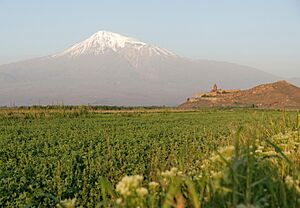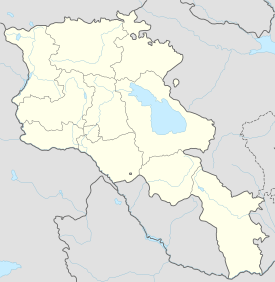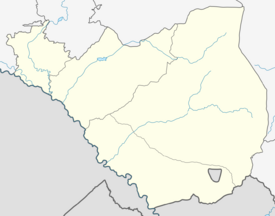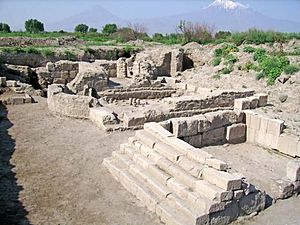Artaxata facts for kids
|
Արտաշատ
|
|

View of Khor Virap Monastery. The hill where the monastery was built is the location of ancient Artaxata (near the village of Lusarat)
|
|
| Location | South of the modern town of Artashat, Ararat Province, Armenia |
|---|---|
| Coordinates | 39°53′06″N 44°34′35″E / 39.88500°N 44.57639°E |
| History | |
| Builder | King Artaxias I |
| Founded | 176 BC |
| Abandoned | 7th century |
Artashat (Armenian: Արտաշատ), also known as Artaxata in Greek, was a very important city in ancient Armenia. It was the capital city from 176 BC to 120 AD, though there were some times when it wasn't.
King Artaxias I (also called Artashes) founded the city. He was the first king of the Artaxiad dynasty. Today, you can find the ruins of Artashat in the Ararat Province of Armenia. They are located near the Araks River, where the Khor Virap monastery now stands. The city was destroyed and rebuilt many times before it was finally left empty in the 7th century AD.
Contents
What's in a Name?
The name Artashat comes from an ancient Iranian word. It means "the joy of Artaxias," named after its founder, King Artaxias I. Other cities like Arshamashat and Eruandashat were also named after their founders.
For a short time in the first century AD, the city was called Neroneia. This was to honor the Roman emperor Nero, who helped rebuild it. Artashat was also known as Ostan Hayotsʻ, which means "court of the Armenians." This was also the name of the area where the city was located.
History of Artashat
Founding the Capital
King Artaxias I started building Artashat in 176 BC. He wanted a new capital city. It was built on a group of nine hills where the Araks and Metsamor rivers met. Some old findings suggest that Artashat might have been built on top of an even older settlement from the Urartu kingdom.
The Armenian historian Movses Khorenatsi wrote about the city's founding. He said that King Artaxias liked the hill where the rivers met and chose it for his new city. Greek historians Plutarch and Strabo shared a story that the famous general Hannibal helped choose the spot. However, there is no real proof for this story.
Artaxias I built a strong citadel (a fortress) on the hill now known as Khor Virap. He also added other defenses, like a moat (a ditch filled with water). You can still see parts of the city's large walls and some buildings today.
A Busy City
Artashat was described as a big and beautiful city. People even called it the "Armenian Carthage." Digs have shown that Artashat was a busy city with paved streets. It had many bathhouses, markets, workshops, and government buildings. The city even had its own treasury, a place to make coins, and a customs office.
Artashat was a center for Greek culture in Armenia. The first theater in Armenia was built here. Old writings say that many copper statues of pagan gods and goddesses were brought to Artashat. These included statues of Anahit, Artemis, and Tir. Jewish people from the old capital, Armavir, also moved to Artashat.
Because of its great location, Artashat quickly became an important stop on trade routes. These routes connected Persia and Mesopotamia with the Caucasus region, the Black Sea ports, and Asia Minor. This helped the city and the area around it grow rich. Thousands of people lived in Artashat, including Armenians, Greeks, Jews, and Syrians. They worked as artists, craftspeople, and traders.
Wars and Changes
Artashat faced many battles over the years. During the time of Tigranes II, Armenia became a huge kingdom. Tigranes built a new capital called Tigranocerta because Artashat was too far away from the new parts of his empire.
In 69 BC, the Roman general Lucullus attacked Armenia. He defeated Tigranes' army and took Tigranocerta. Later, another big battle happened near Artashat. Roman writings say Tigranes was defeated again. But Lucullus had to turn back and never took Artashat. The city also survived an attack by the Parthians.
Later, Pompey attacked Artashat. To save the city, Tigranes agreed to Roman rule and gave up most of the lands he had conquered.
For the next 200 years, Artashat was often a target in wars. In 34 BC, Mark Antony marched on Artashat and captured King Artavasdes II. In 58–59 AD, Roman soldiers destroyed the city.
After this, Emperor Nero helped King Tiridates I rebuild Artashat. He gave him a lot of money and sent builders. The city was even called Neroneia for a while to honor Nero.
Decline and Abandonment
The Roman emperor Trajan conquered Armenia around 115 AD. He made it a Roman province for a short time. Romans set up a military base in Artashat. We know this because a Latin writing mentioning Trajan was found there.
In 163–164 AD, the Romans attacked again and destroyed Artashat. After this, Vagharshapat became the capital of Armenia, at least for a while. In the mid-3rd century, the royal court moved to Duin.
In the late 360s, the Sasanian king Shapur II completely destroyed Artashat. After Armenia was divided between Sasanian Iran and the Eastern Roman Empire, Artashat became one of the few places where trade between the two empires was allowed.
In 449, before a big Armenian rebellion, Christian leaders met in Artashat. They talked about threats from the Sasanian king Yazdegerd II. During the rebellion, the city was destroyed again. As Duin grew more important, Artashat quickly declined. The rivers around Artashat also changed course and caused floods. This likely led to the city finally being left empty.
Archaeologists found the exact spot of ancient Artashat in the 1920s. Digs began in 1970. The old city site is about 8 kilometers (5 miles) south of the modern city of Artashat, near the Khor Virap monastery.
Images for kids
-
Latin inscription of Trajan's 4th Legion found north of the city, outside the wall of 116 AD
See also
 In Spanish: Artaxata para niños
In Spanish: Artaxata para niños














